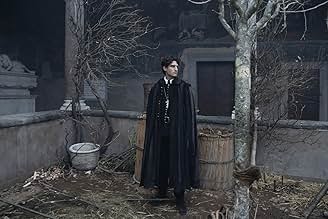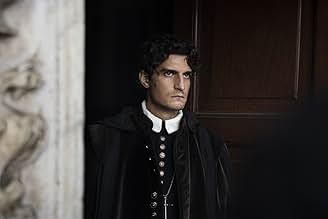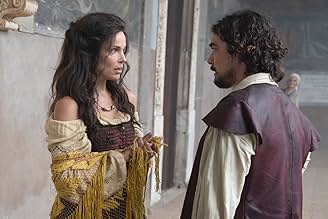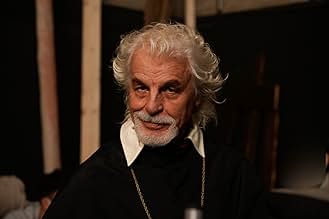L'ombra di Caravaggio
- 2022
- 2 h
AVALIAÇÃO DA IMDb
6,5/10
1,9 mil
SUA AVALIAÇÃO
A Igreja Católica investiga secretamente Caravaggio enquanto o Papa pondera se deve conceder-lhe clemência por ter matado um rival.A Igreja Católica investiga secretamente Caravaggio enquanto o Papa pondera se deve conceder-lhe clemência por ter matado um rival.A Igreja Católica investiga secretamente Caravaggio enquanto o Papa pondera se deve conceder-lhe clemência por ter matado um rival.
- Direção
- Roteiristas
- Artistas
- Prêmios
- 13 vitórias e 6 indicações no total
- Direção
- Roteiristas
- Elenco e equipe completos
- Produção, bilheteria e muito mais no IMDbPro
Avaliações em destaque
The movie is the story of Michelangelo Merisi da Caravaggio who was an Italian painter in the 16th century, through the eyes of the Pope's investigator. He was known for painting "what he saw", some kind of reality that he wanted close to the divine, which was of course not ok with the Catholic Church. Within his paintings, you could see famous prostitutes, hoboes, represented as saints, such as Mary or St Peter. His life has multiple legends around it, he was known to have sexual relationships with both males and females, while painting for the Church, and his competitors tried to destroy him for that. He had to flee Rome after killing (accidentally?) someone and lived in Naples, Sicily, Malta, etc. The story of the movie is a bit long, but this is not why you should see this movie. The whole movie is staged as a painting, with that kind of atmosphere that you get from 16th century Italian paintings. Would I watch it again? No, but I am happy I watched it.
Caravaggio's Shadow is a fever dream of a film, vividly photographed and convincingly played by an (unsurprisingly) handsome Italian cast.
There's plenty of melodrama, but it's an Italian period piece; anything less would have felt restrained.
At the heart of it is an irresolvable contradiction: the Vatican and papacy are the immensely rich and powerful core of Catholicism, but Catholicism is anchored by the teachings of Jesus, friend of the poor, the outcast and the desperate. What happens when the Vatican's most talented painter - a devout genius - uses the poor, the disgraced, and the outcasts of society as his subjects in seeking the truth of scripture?
Expect plenty of debauchery, plenty of on-location renaissance architecture, some intrigue, and even some swashbuckling swordfighting.
Worth your time.
There's plenty of melodrama, but it's an Italian period piece; anything less would have felt restrained.
At the heart of it is an irresolvable contradiction: the Vatican and papacy are the immensely rich and powerful core of Catholicism, but Catholicism is anchored by the teachings of Jesus, friend of the poor, the outcast and the desperate. What happens when the Vatican's most talented painter - a devout genius - uses the poor, the disgraced, and the outcasts of society as his subjects in seeking the truth of scripture?
Expect plenty of debauchery, plenty of on-location renaissance architecture, some intrigue, and even some swashbuckling swordfighting.
Worth your time.
A decent but no notable retelling of the life of the celebrated 17th-century painter through his brilliant, nearly blasphemous paintings and his flirtations with the underworld. Caravaggio proceeded to develop a new style of painting giving a more realistic view of the world in which he lived. He also begins love affairs with his models, and relations with lower life people: prostitutes, hobos , beggars, street fighters, and robbers. Their relationship leads to murder and deceit. After fleeing Rome accused of murder, Caravaggio takes refuge in Naples, under the protection of the Colonna family, there he awaits a possible absolution from Pope Paul V. Caravaggio proceeded to develop a new style of painting giving a more realistic view of the world in which he lived. When Pope awares Carvaggio (Riccardo Scamarcio) uses bad-life women, thieves and vagabonds as models for his religious works, he orders to investigate him secretly. For this reason, an inquisitor (Louis Garrel) is sent to find him and interrogate him, as the Pope weighs whether to grant him clemency for killing a rival. Along the way, Caravaggio is protected by aristocrat Costanza Sforza Colonna (Isabelle Huppert) . Following some sad events, Caravaggio stayed a few more months in Naples and finally left for Malta, the seat of the Knights of Malta. It is believed that his trip was sponsored by Alof de Wignacourt, Grand Master of the Order. De Wignacourt was so pleased with the painter's work that he proposed him as a candidate for the Order. In 1608 the painter was named a knight of grace and devotion of the Sovereign Military and Hospitaller Order of Saint John of Jerusalem, of Rhodes and of Malta.
The film is acceptable and passable but it gets bogged down in the darkest, most critical and painful moments of the painter's life, which is why it is somewhat unsympathetic and unpleasant to watch. Thus, the movie recreates a multitude of sexual moments, orgies, murders, with a lot of dirty and ugly characters, describing dark, impious people or evil inquisitors. Although Caravaggio's life could have developed in this way, it is not necessary to recreate his life so dark and creepy. See instead the example of the much better biography of Michelangelo: ¨The Agony and the Ecstasy¨ by Carol Reed with Charlton Heston, which despite being much longer was much more entertaining, bright and enjoyable to watch. And that is even though Michelangelo also lived a life in poverty and related to people of all social classes, especially the lower classes, and also suffered persecution.
The protagonist Riccardo Scamarcio, who gives adequate acting, is well accompanied by an international cast of known actors, such as: Isabelle Huppert (Elle) and Louis Garrel (Little Women), the latter plays the role of the Vatican emissary in charge of investigating what is hidden behind his works. The motion picture was mediocrely directed by Michele Placido.
Caravaggio captured close anatomical observation with a dramatic use of chiaroscuro that came to be known as tenebrism. This technique became a dominant stylistic element, darkening shadows and transfiguring objects into brilliant shafts of light. He vividly expressed crucial moments and scenes, often involving violent struggles, torture and death. He worked quickly from life models, eschewing sketches to work directly on canvas. His influence was profound on the new Baroque style that emerged from Mannerism and can be traced in the works of such great masters as Peter Paul Rubens, José de Ribera, Rembrandt and Diego Velázquez. His pictorial work was immense (many of them appear in the film): Medusa, Love Victorious (1602) shows Cupid above all earthly powers: war, music, science, government. The Death of the Virgin, The Conversion of Saint Paul on the Road to Damascus, Seven Works of Mercy, Saint Jerome Writing, The Flagellation of Christ, The Beheading of Saint John the Baptist (the only painting by Caravaggio with his signature). The Burial of Saint Lucy, The Raising of Lazarus and The Adoration of the Shepherds. And Portrait of the Grand Master of the Order of Malta Alof de Wignacourt, as well as portraits of other knights of the Order.
There are various biographic adaptations: 1941 ¨Caravaggio¨ directed by Goffredo Alessandrini, produced by Elica Film.1986 ¨Caravaggio¨ directed by Derek Jarman, with Nigel Terry, Sean Bean, Dexter Fletcher, Spencer Leigh, Tilda Swinton, Michael Gough. 2007 ¨Caravaggio The Shadow of Genius¨, directed by Angelo Longoni, produced by Ida di Benedetto and Stefania Bifano, for Titania Produzioni, two-part television miniseries. 2018 ¨Caravaggio - The Soul and the Blood¨ directed by Jesus Garces Lambert.
The film is acceptable and passable but it gets bogged down in the darkest, most critical and painful moments of the painter's life, which is why it is somewhat unsympathetic and unpleasant to watch. Thus, the movie recreates a multitude of sexual moments, orgies, murders, with a lot of dirty and ugly characters, describing dark, impious people or evil inquisitors. Although Caravaggio's life could have developed in this way, it is not necessary to recreate his life so dark and creepy. See instead the example of the much better biography of Michelangelo: ¨The Agony and the Ecstasy¨ by Carol Reed with Charlton Heston, which despite being much longer was much more entertaining, bright and enjoyable to watch. And that is even though Michelangelo also lived a life in poverty and related to people of all social classes, especially the lower classes, and also suffered persecution.
The protagonist Riccardo Scamarcio, who gives adequate acting, is well accompanied by an international cast of known actors, such as: Isabelle Huppert (Elle) and Louis Garrel (Little Women), the latter plays the role of the Vatican emissary in charge of investigating what is hidden behind his works. The motion picture was mediocrely directed by Michele Placido.
Caravaggio captured close anatomical observation with a dramatic use of chiaroscuro that came to be known as tenebrism. This technique became a dominant stylistic element, darkening shadows and transfiguring objects into brilliant shafts of light. He vividly expressed crucial moments and scenes, often involving violent struggles, torture and death. He worked quickly from life models, eschewing sketches to work directly on canvas. His influence was profound on the new Baroque style that emerged from Mannerism and can be traced in the works of such great masters as Peter Paul Rubens, José de Ribera, Rembrandt and Diego Velázquez. His pictorial work was immense (many of them appear in the film): Medusa, Love Victorious (1602) shows Cupid above all earthly powers: war, music, science, government. The Death of the Virgin, The Conversion of Saint Paul on the Road to Damascus, Seven Works of Mercy, Saint Jerome Writing, The Flagellation of Christ, The Beheading of Saint John the Baptist (the only painting by Caravaggio with his signature). The Burial of Saint Lucy, The Raising of Lazarus and The Adoration of the Shepherds. And Portrait of the Grand Master of the Order of Malta Alof de Wignacourt, as well as portraits of other knights of the Order.
There are various biographic adaptations: 1941 ¨Caravaggio¨ directed by Goffredo Alessandrini, produced by Elica Film.1986 ¨Caravaggio¨ directed by Derek Jarman, with Nigel Terry, Sean Bean, Dexter Fletcher, Spencer Leigh, Tilda Swinton, Michael Gough. 2007 ¨Caravaggio The Shadow of Genius¨, directed by Angelo Longoni, produced by Ida di Benedetto and Stefania Bifano, for Titania Produzioni, two-part television miniseries. 2018 ¨Caravaggio - The Soul and the Blood¨ directed by Jesus Garces Lambert.
Carravaggio
For fully appreciate this movie, it help to be a fan of the work of the painter ...as one understand more what was the motivation behind his choices , and why his works were so controversial yet so good...the Catholic Church at the time was the Church, the only one yet the rise of what would become the Protestant churches were making the Vatican nervous.
The conflict between the reality of life of the average people and the grandiose representation of the saints ...had no much income ...
Knowledge of some of the work of Caravaggio help understanding lots of scenes in this movie ...and what makes his work so good is what was no conceivable at the time...that you could use the face of common daily people to personified a saint , an angel ..which of my God of the time had no gender, no sex...
For fully appreciate this movie, it help to be a fan of the work of the painter ...as one understand more what was the motivation behind his choices , and why his works were so controversial yet so good...the Catholic Church at the time was the Church, the only one yet the rise of what would become the Protestant churches were making the Vatican nervous.
The conflict between the reality of life of the average people and the grandiose representation of the saints ...had no much income ...
Knowledge of some of the work of Caravaggio help understanding lots of scenes in this movie ...and what makes his work so good is what was no conceivable at the time...that you could use the face of common daily people to personified a saint , an angel ..which of my God of the time had no gender, no sex...
The hypocrisy of key Church figures who condemn the sensuality of the painter, all the while competing to hoard his art seems bizarre, the figure of Caravaggio becomes an attractive and sympathetic revolutionary hero in a secular era. While his animalistic rutting grosses me out he gets the best lines. The investigator who travels around interviewing witnesses is so intent on his task he becomes one-dimensional. But the film suffers from such poor narrative construction that it becomes tedious and repetitive, gradually dulling my interest. If the powerful originality of the artist's output were shown more clearly I would have found it more enjoyable.
Você sabia?
- CuriosidadesRiccardo Scamarcio said about Caravaggio's character: "I immediately thought that [Caravaggio] was like Elvis Presley. My reference was Elvis. A small-town boy with great energy, passion, talent and rigor towards art. At that time, painting was the mainstream, there was nothing else, there was no photography, there was no radio, television or cinema. Paintings were so powerful because they spoke directly to the unconscious. And this man was the first to represent sacred images in a completely different way."
- Erros de gravaçãoTodas as entradas contêm spoilers
Principais escolhas
Faça login para avaliar e ver a lista de recomendações personalizadas
- How long is Caravaggio's Shadow?Fornecido pela Alexa
Detalhes
Bilheteria
- Orçamento
- € 12.261.966 (estimativa)
- Faturamento bruto mundial
- US$ 4.895.695
- Tempo de duração2 horas
- Cor
- Proporção
- 2.39 : 1
Contribua para esta página
Sugerir uma alteração ou adicionar conteúdo ausente

Principal brecha
By what name was L'ombra di Caravaggio (2022) officially released in India in English?
Responda


























